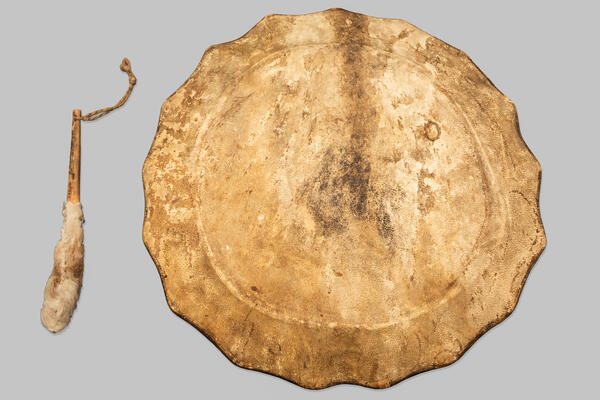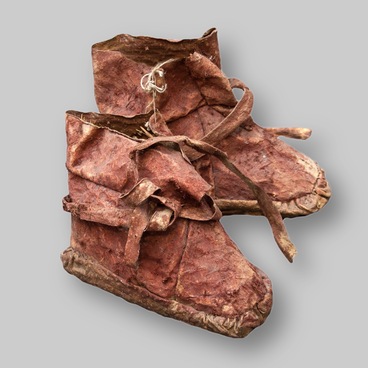A tambourine is an essential attribute for powerful shamans. For a shaman, a tambourine is like a winged horse that he uses to complete his journey across the three-dimensional world, and that he feeds with milk and arak, so it’s a milk-laden vodka. The tambourine presented in the collection was taken from a public building that was constructed especially for the bear ceremony. The last time that anyone practiced shamanism with it was in 1936.
The frame for the tambourine in the collection of the Tobolsk Museum is a wooden hoop 10 centimeters wide, and in the center there are 17 wooden struts inserted perpendicular to the surface as sound cavity supports. The hoop was frequently made from larch or birch. Elk leather was stretched over the frame of the tambourine presented in this collection. Thanks to the struts, the outside line of the tambourine takes on a wavy form. The inner surface of the hoop was decorated with small bells of various sizes, and with rings hung on two wires, with ten on each of them. Now there are only two bells on the hoop, attached at the base of the handle, and the remains of a bent wire. On the outer surface there are no images or decorations - this is a characteristic detail for tambourines made by various groups of Khanty, an indigenous Ugric people. Occasionally, the Khanty depicted simple circles on the surface of the tambourine.
The frame for the tambourine in the collection of the Tobolsk Museum is a wooden hoop 10 centimeters wide, and in the center there are 17 wooden struts inserted perpendicular to the surface as sound cavity supports. The hoop was frequently made from larch or birch. Elk leather was stretched over the frame of the tambourine presented in this collection. Thanks to the struts, the outside line of the tambourine takes on a wavy form. The inner surface of the hoop was decorated with small bells of various sizes, and with rings hung on two wires, with ten on each of them. Now there are only two bells on the hoop, attached at the base of the handle, and the remains of a bent wire. On the outer surface there are no images or decorations - this is a characteristic detail for tambourines made by various groups of Khanty, an indigenous Ugric people. Occasionally, the Khanty depicted simple circles on the surface of the tambourine.



